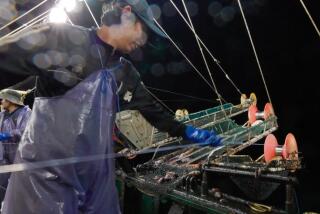Fish and Shellfish Month : Supply of Many Seafood Varieties Strengthens in Recent Years
- Share via
WASHINGTON — October is the time to come out of your shell and enjoy the bounty of wholesome fish and shellfish. With 31 days devoted to one of America’s healthiest and most natural fast-foods, now is the time to get cracking.
The National Fisheries Institute says consumers can expect excellent supplies of shrimp, salmon, trout and catfish. The supply of these species has become stronger and more consistent in recent years due to aquaculture in the United States and abroad, the institute says.
Consumers can also expect cod and swordfish and a variety of mollusks and shellfish such as mussels, oysters, clams and scallops to be in good supply. Look for good buys on regional species, such as tuna or shark steaks, as well as local favorites.
In addition to fresh and frozen, there is a wide variety of processed seafood products--breaded seafood items, surimi seafoods, canned and smoked products--that offer busy cooks convenience, taste and economical alternatives.
Reducing the Fat
Research indicates that eating seafood in place of high fat and cholesterol-laden foods can help lower the risk of cardiovascular disease primarily by reducing the intake of total fat and saturated fat. Consider these seafood nutrition facts:
--A 4-ounce portion of seafood contains approximately 100 calories.
--The Omega-3 fatty acids found in fish and shellfish are believed to play a role in reducing the risk of heart disease.
--Seafood is nutrient-dense. It offers large quantities of protein and significant amounts of vitamins and minerals without high levels of saturated fats and cholesterol.
--Seafood is an excellent source of complete protein. A single serving of seafood can provide a large portion of daily protein needs, and it is easily digestible.
--Seafood is generally low in sodium. Most fresh fin fish contain very low amounts of sodium. Sodium levels of shellfish and processed fin fish tend to be slightly higher depending on processing and can be incorporated into a low-sodium diet.
All fish and seafood is subject to inspection by the U.S. Food and Drug Administration and the National Oceanic and Atmospheric Administration.
Plant Inspections
These agencies inspect plants to assure compliance with sanitation and processing regulations. They also spot check products for conformance to regulations on pesticides and other contaminants.
Other seafood safety facts from the National Fish and Seafood Promotional Council:
--All imported products are subject to inspection at the port of entry by the Food and Drug Administration.
--Many major seafood companies subscribe to a voluntary federal inspection program provided by the U.S. Department of Commerce.
--Fish and seafood are subject to inspection by state authorities. Coastal states monitor local waters and, in the case of shellfish, close any beds that are polluted.
--Oysters, clams and mussels are siphon feeders, which means they nourish themselves by eating nutrients in the water; therefore, they can ingest pathogens. For this reason, a special program has been established by federal and state authorities to monitor shellfish-growing waters and close beds that have become polluted.
--More than 90% of the fish consumed is caught three miles or more from shore; that distance from coastal waters offers protection from direct pollution.
--Fish caught by recreational fishermen close to shore should not be eaten if caught in polluted waters. States routinely issue warnings to recreational fishermen.
--Available data on reports of human illness indicate that most problems relating to seafood have been caused by a few species known to federal and state authorities. Steps have been taken to reduce risk to consumers.
More to Read
Eat your way across L.A.
Get our weekly Tasting Notes newsletter for reviews, news and more.
You may occasionally receive promotional content from the Los Angeles Times.










